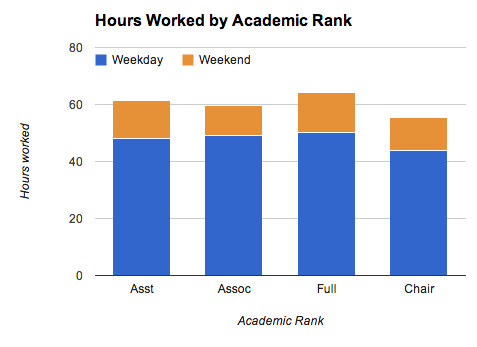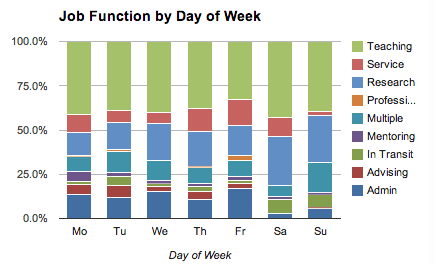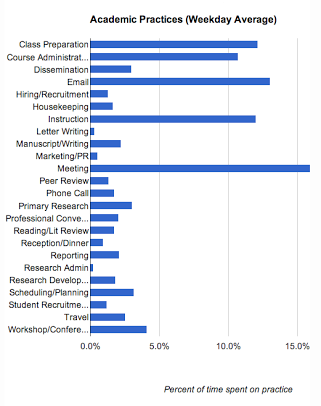You have /5 articles left.
Sign up for a free account or log in.
Professors work long days, on weekends, on and off campus, and largely alone. Responsible for a growing number of administrative tasks, they also do research more on their own time than during the traditional work week. The biggest chunk of their time is spent teaching.
Those are the preliminary findings of an ongoing study at Boise State University -- a public doctoral institution -- of faculty workload allocation, which stamps out old notions of professors engaged primarily in their own research and esoteric discussions with fellow scholars.
“The ivory tower is a beacon — not a One World Trade Center, but an ancient reflection of a bygone era — a quasar,” John Ziker, chair of the anthropology department at Boise State University, says in a new scholarly blog post in which he discusses his faculty workload findings. “In today’s competitive higher-education environment, traditional universities and their faculty must necessarily do more and more, and show accomplishments by the numbers, whether it be the number of graduates, the number of peer-reviewed articles published or the grant dollars won.”
Ziker’s Blue Review post continues: “It is harder to count — and to account for — service and administrative duties. These are things we just do because of the institutional context of Homo academicus, and it’s hard to quantify the impact of these activities or the time spent, but they are exceedingly important for intellectual progress of the larger Homo clans.”
But of course just how professors spend their time has major implications for faculty, students and their institutions, he says – especially as Boise State has recently adopted a policy that professors should spend 60 percent of their time teaching. Hence the need for the Time Allocation Workload Knowledge Study, or “TAWKS.”
Using a modified version of the anthropological technique “24-hour recall,” 30 tenure-track and tenured study participants were asked to report everything they did from 4 a.m. on the previous day to the day of the recall interview. Ziker says the technique is especially good at capturing rare and common activities than other methods. About half the participants provided a full week’s worth, or seven days, of data, and others provided one to six days’ worth of data. Responses for all 166 days were coded to determine exactly how the professors were spending their working hours. (Time spent on truly personal activities was not included in the study.)
The study is only in its early stages, and the findings from what Ziker calls Phase 1 are anything but conclusive. The sample size is small and participants were not chosen randomly (all 550 Boise State full-time faculty members were asked to participate but just 30 responded). But Ziker says the findings are “highly suggestive” because they are so consistent across participants. In an interview, Ziker said he didn't know how representative the findings were of institutions others than Boise State, but said that future phases of the study would involve outside professors.
On average, faculty participants reported working 61 hours per week – more than 50 percent over the traditional 40-hour work week. They worked 10 hours per day Monday to Friday and about that much on Saturday and Sunday combined. Perhaps surprisingly, full professors reported working slightly longer hours both during the week and on weekends than associate and assistant professors, as well as chairs.

Ziker says the most surprising finding so far is that faculty participants spent 17 percent of their work week in meetings – including those with students – and 13 percent of the day on email (both for research and with students).
So combined, he says, 30 percent of faculty time “was spent on activities that are not traditionally thought of as part of the life of an academic.”
About one-third of work-week days – 35 percent – was spent on teaching, including 12 percent for instruction and 11 percent on course administration, such as grading and updating course webpages.
Just 3 percent of the work-week day was spent on primary research and 2 percent was spent on manuscript writing.
On the weekend, faculty spent about 23 percent of their working time on class preparation, 13 percent on course administration, 10 percent of the time on email, and 9 percent at workshops and conferences. Professional conversations, manuscript writing and “housekeeping," such as updating files, rounded out of the rest of the time.
Combining work week and weekend, faculty subjects spent about 40 percent of their time on teaching-related tasks, or about 24.5 hours.
Ziker points out that 24.5 hours is almost exactly 60 percent of a 40-hour work week.
“So, what is happening?” he asks. “Are faculty shirking their teaching duties, or is workload policy geared for a time and place when success was defined largely by teaching?”

Probably not. Because research – “and the external funding and recognition it brings” – makes up just 17 percent of the work week and 27 percent of weekend work, he says, faculty members have an “entrepreneurial spirit, a willingness to exploit their free time for work.”
Matthew Genuchi, a professor of psychology at Boise State who is Ziker's co-investigator (along with assistant professors of anthropology Kathryn Demps and David Nolin), said in an interview that "there appears to be something quite paradoxical occurring" with the findings on research, given that research and grants are "the most valued in the tenure and promotion process." He noted, however, that the study did not take into account summer work habits -- when faculty members may have more time to do research. Ziker said that is when he personally gets most of his research and writing done, as well as during other breaks throughout the year.
The study also gives insight into exactly where professors are carrying out their work. Some 59 percent of work – or 36 hours per week – takes place on campus, with 24 percent of work taking place at home and 17 percent of work taking place at other off-campus locations.
As to how academics are working, the study suggests they’re working mostly on their own – alone 57 percent of the time. Only 17 percent of participant time was spent doing activities with colleagues and 15 percent of our time was spent doing activities with students.
“Being a faculty member appears to be a lonely occupation,” Ziker says.
Genuchi said he was surprised by the "loneliness" finding. It demands further study, he said, but one possible implication could be that "faculty may feel generally isolated even though they work in a setting that is full of people, including colleagues and students."
Additionally, he said, it may be saying something about the overall trend in higher education toward inter- or transdisciplinarity. "While faculty may be shifting toward engaging in work with colleagues across disciplinary lines, they appear to be engaging in a majority of that work in isolation."
Ziker agreed, saying that the dynamic stands in particular contrast to graduate school or post-doctoral appointments, when "academics are used to having a lot of time in conversations and contact with colleagues."
When faculty members were working with other faculty members, the main activities were meetings, professional conversations, conferences and workshops and research dissemination.
Collaborative research and especially teaching “appears to take a back seat in faculty meetings,” Ziker says.

The American Association of University Professors doesn’t have good, recent data on faculty workload allocation with which to compare the TAWKS data. The best available data, from 2003 (taken from the National Study of Postsecondary Faculty), show that full-time faculty members work 53.4 hours in a week. About 62 percent of that was teaching, including course preparation and advising, with 18 percent devoted to research and 20 percent to percent administrative and other tasks.
For full-time faculty members at four-year colleges and universities, such as Boise State, those figures show that faculty worked 54.4 hours per week, with about 58 percent of time spent on teaching, 22 percent of time on research and 20 percent on administrative and other tasks.
John Curtis, director of research and public policy for the AAUP, said there currently is “a lot of pressure on faculty members to increase the time they spend on all three aspects of their work.”
Legislators and the general public emphasize teaching as a priority, he said, “because that’s what they think of as the primary, if not exclusive, work of faculty members, and it’s very visible.” Tuition also brings in additional revenue in for colleges and universities in some situations,” he said, “which administrators like.”
At the same time, institutions value research because it brings in external funding, Curtis said – a point Ziker makes. It’s also the “primary source of visibility and rewards,” such as publication, tenure and promotions, for faculty members.
Many tasks fall under the “broad heading” of service, Curtis said, and there’s also administrative reporting to the institution: student learning assessment exercises and reports; committees for hiring, promotion, curriculum, and budget planning; departmental, school or college, and university administration; student activities; and service to disciplinary associations and community service organizations.
So the best answer to the question, “How do faculty members get anything done?” is “most often that they work longer hours” he said.
Ziker, Genuchi, Demps and Nolin currently are working on Phase 2 of the study, in which participants will use a smartphone app they've developed. The phase will be based on a method called “experience sampling,” in which participants respond or “check in” to text messages they receive at random times, to report what they are doing. The phase also includes a daily self-report about satisfaction with daily productivity.
“Linking time allocation to productivity will allow us to investigate a number of ideas about what makes for successful and happy faculty,” Ziker says.
Ultimately, the TAWKS team wants to develop a tool to help faculty reflect regularly on their productivity levels and work patterns.
“Promoting accountability to self demonstrates academic freedoms and provides a way to augment the reporting approach to workload that is likely not going away,” Ziker says. “If we can make the road of Homo academicus less lonely in the process, it won’t seem long at all.”









